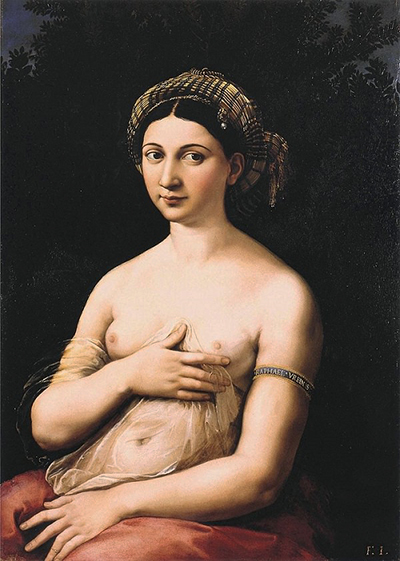La Fornarina is a painting surrounded in mystery and love and is the cause of much speculation. Nobody knows for sure who the young woman is, but it is highly likely that she was the mistress of Raphael and the woman he loved more than anyone.
It is an oil on wood painting by the renaissance great Raphael. It was painted between 1518 and 1520, and would have been still in his studio, unfinished, at the time of his sudden and unexpected death aged just 37.
The painting utilises a classic realism style typical of renaissance art and indeed the art of Raphael himself. There is a strong and powerful use of light evident here which shrouds the subject in a glowing light, further enhancing her beauty and innocence. She smiles sweetly towards the painter and therefore towards the viewer, a pose evocative of love.
The black background sets this off and enhances the model’s gentle beauty.
The young lady in the painting is pictured wearing an oriental style hat or headscarf and an armband around her left arm which bears the name of the artist. She is holding a sheer robe up to her chest, leaving the breasts exposed. Her right hand reaches across to touch her left breast to mirror the pose seen in classical depictions of women, such as the Venus Puclica statue.
It is widely accepted that this painting is of Margarita Luti, a young woman who also sat for Raphael's La Valata. Little is known of Margarita’s life, apart from the fact that she was the daughter of a baker and that it is highly likely that she and Raphael were lovers. Raphael was well known for having an eye for the ladies, but in this case it seems that she may have stolen his heart, with historic accounts written about the artist’s life mentioning his strong feelings towards her.
There may be some merit to this claim – looking at the painting it is clear to see the soft, loving expression with which she gazes at him, and the care he has taken to replicate her beauty and personality with his tender brushstrokes is evocative of love.
Whilst being one of the finest portrait painters, there were other significant names who captured female beauty on canvas. Botticelli's career included The Birth of Venus, Primavera and Portrait of a Young Woman.
X-rays of the painting later revealed that originally the model was wearing a ruby ring on the third finger of her left hand, perhaps hinting at a betrothal between the two. Since the painting remained unfinished at the time of Raphael's death, it is probable then that Raphael's assistant added some finishing touches to the piece before putting it up for sale. This could have included covering up the ring in order to keep the true nature of the couple’s relationship secret.
Raphael was engaged to a woman named Maria for six years before his death, but kept delaying the wedding. Could that be because he was already wed to another? The engagement gave him status and a platform from which to produce and sell his art, so he may have been reluctant to give that up, yet unable to marry his fiancé since has was already betrothed to another. It could be that this painting is the only relic we have of a tragic, yet deeply romantic story of forbidden love.
Whatever the story behind this piece however, there is little doubt that it is a remarkable portrait of a beautiful woman. Taken purely on aesthetic value, this is a wonderful piece of art which has enchanted audiences since it was first created and is a true masterpiece of the renaissance era.




